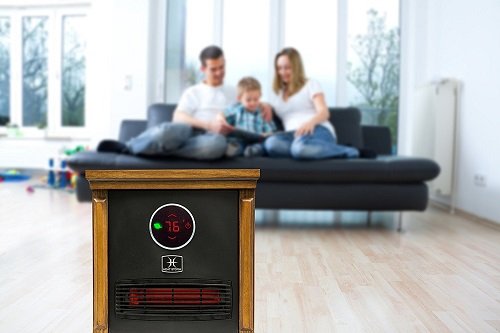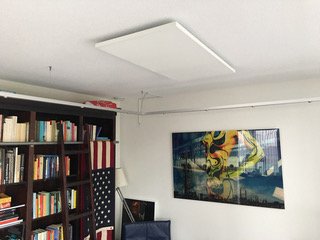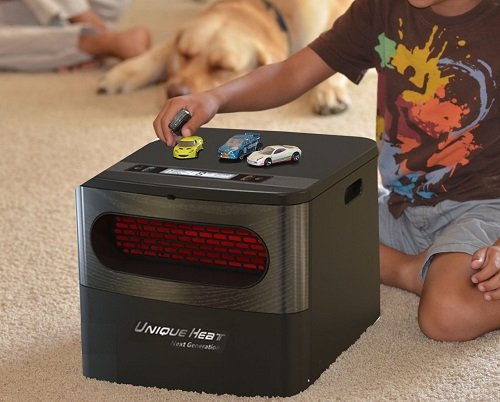No, infrared heaters cannot damage furniture. Unlike the sun, infrared heaters do not emit harmful UV-light. And since infrared heating does not dry the air, it is the safest heating option for your furniture.
Furniture can get damaged in three ways:
- UV-light (from the sun) causes the colors of your furniture to fade
- direct intense heat can leave stains or burns on (wooden) furniture, or melt upholstery.
- a change in the moisture content of wooden furniture can lead to expansion or contraction, leading to contortions or cracks.
Infrared heaters do not cause any of the above, unlike regular space heaters or the sun.
Additionally, according to Herschel, a leading manufacturer of infrared heaters:
“Radiant heating panels allow an environment to maintain a higher temperature in the building material versus a lower air temperature. This dries out rooms and buildings and results in less moisture build-up, with the great benefit to buildings of less condensation, less corrosion of metal parts, and less damage to paintwork. Additionally, infrared heating is excellent for reducing moisture and mildew.”
Infrared heating dries out rooms and buildings and results in less moisture build-up, less condensation, less corrosion of metal parts, and less damage to paintwork.
Infrared heaters do not emit damaging UV-light
Outdoor furniture and pillows are known to suffer stains, discoloration, and cracks from standing in the sun for long periods of time. Infrared heating, however, does not cause the same problems. Sun-related damage is caused by exposure to UV-light, which is not emitted by infrared heaters.
The sun emits all kinds of radiation including visible light, UV-light and infrared. Infrared is mostly responsible for the sun’s warmth, while UV-light can cause damage to objects and our skin. Infrared heaters are designed to only emit infrared radiation. Although some infrared heaters emit a little bit of visible red light, no heater emits UV-light.
Therefore, stains on wood, or the fading of pillows will not be an issue when using infrared heaters.

Infrared heaters do not cause over-heating
Infrared heaters will not cause heat damage to furniture when used, installed, and maintained properly. This is most easily explained by how infrared heating works.
How does infrared heating work?
Infrared heaters emit infrared radiation. This type of heating does not heat up the air. The radiation transfers its heat to any object it comes into contact with. That can be you, or the furniture in your room. This is the same heat you experience when you feel the sun’s warmth upon your skin (without the harmful UV-light!).
Objects that are not hit by the infrared rays are not heated. This is similar to sitting on a terrace in the sun. Your legs feel cold as the sun is blocked by the table, while your face feels warm thanks to the sun’s rays.
Infrared heating heats your furniture directly
Infrared heating heats objects directly. The infrared rays pass through the air and transfer their heat to any object they come into contact with.
Regular space heating heats your furniture indirectly. It heats the air, and the air heats the furniture. However, much of this heat is lost to heating objects and areas that do not require heating for a comfortable temperature at home. Infrared heating is therefore much more efficient, heating only the objects and people at which it is pointed.
Unlike for example a wood stove, the air does not get heated nearly as much with infrared heaters. Therefore, since the furniture is heated directly, your furniture will release its excess heat to the surrounding air. In this way, furniture can always lose excess heat.
Preventing heat damage to objects by infrared heat
In order to prevent furniture and other objects from getting too hot, make sure to maintain a safe distance between the heater and other objects in the room.
Infrared heaters can be divided into three categories. Each requires different safety precautions. The three types are:
- Infrared heating panels
- Portable infrared space heaters
- Indoor/outdoor wall or ceiling mounted infrared heaters
Infrared panels safety precautions

Infrared panels do not get very hot and can even be touched for a second. Household models typically do not exceed 50 degrees Celcius (100 degrees Fahrenheit). Therefore, no heat damage or fire hazard is present as long as nothing touches the infrared panel. However, the following safety precautions are advised:
- do not place any objects closer than 40 cm (15 inch) in front of the panel
- do not place any objects closer than 20 cm (7.5 inch) to the sides of the panel
My own 700W infrared panel is mounted on the wall only 2 to 3 centimeters above my couch. However, even after running the panel for two hours, the upholstery does not get very hot.
Portable infrared space heaters safety precautions
Portable infrared space heaters do get very hot inside. They can heat u to 1000 degrees Celcius (1800 degrees Fahrenheit). However, they all come with a housing that can safely be touched.

These types of infrared heaters can lead to some issues when they are used improperly. Therefore, the following safety precautions need to be ensured:
- make sure the heat outlet/opening is never covered
- make sure no combustible materials such as papers and curtains are closer than 1 meter (3 feet) from the front of the heater
- do not let any object touch the sides and back of the heater
Indoor/outdoor mounted infrared heaters safety precautions

Infrared heaters that are suitable for outdoor use emit the most intense infrared heat. This makes them suitable for outdoor patio and terrace heating even on a windy day. They are also suitable for indoor heating, however, this requires a safe distance from other objects.
- the heater needs to be mounted in a high position, at least 72 inches (1.8 meters) from the floor
- the heater needs to be clear from other objects. 24 inches (0.6 m) from the top, and 18 inch (0.45 m) from the sides
Additionally, these wall or ceiling mounted heaters tend to have less protective housing compared to the portable heaters discussed above. Therefore, they are not safe to touch.
How to prevent moisture-related heat damage to furniture
Wooden furniture is prone to moisture-related heat damage. Since wood contains moisture, any changes in moisture content can cause the wood to contract or expand. This can lead to severe damage in the form of cracks or contortions.
Maintaining a constant temperature and air humidity is best to protect your furniture. Since regular space heaters dry out the air, your furniture will suffer during the winter when your heating system is very active. Or, when your furniture is used to the dry indoor air in winter, summertime will cause problems due to excess moisture. For this, a dehumidifier is a great tool.
Infrared heating helps to keep a constant humidity
Infrared heating can be a great solution to moisture probems as it does not dry out the air. Therefore, the moisture content of your indoor air is not changed when more heating is desired.
Changing from regular to infrared heating
Let’s say you currently have regular space heating and are considering switching to infrared heating. What does this do to your furniture?
If you are using your space heater irregularly during the year, you are putting your wooden furniture at risk of moisture-related damage. As described above, a fluctuating moisture content can lead to severe furniture damage.
However, when you decide to switch to infrared space heating, you will mostly eliminate this problem. Since you are no longer drying the air when you turn on the heater, the humidity levels will stay relatively constant, and your furniture is safe.

1 thought on “Can infrared heaters damage furniture?”
Comments are closed.